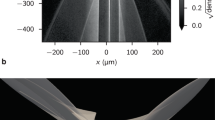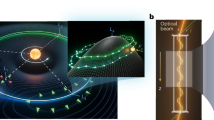Abstract
One of the most fascinating predictions of the theory of general relativity is the effect of gravitational lensing, the bending of light in close proximity to massive stellar objects. Recently, artificial optical materials have been proposed to study the various aspects of curved spacetimes, including light trapping and Hawking radiation. However, the development of experimental ‘toy’ models that simulate gravitational lensing in curved spacetimes remains a challenge, especially for visible light. Here, by utilizing a microstructured optical waveguide around a microsphere, we propose to mimic curved spacetimes caused by gravity, with high precision. We experimentally demonstrate both far-field gravitational lensing effects and the critical phenomenon in close proximity to the photon sphere of astrophysical objects under hydrostatic equilibrium. The proposed microstructured waveguide can be used as an omnidirectional absorber, with potential light harvesting and microcavity applications.
This is a preview of subscription content, access via your institution
Access options
Subscribe to this journal
Receive 12 print issues and online access
$209.00 per year
only $17.42 per issue
Buy this article
- Purchase on Springer Link
- Instant access to full article PDF
Prices may be subject to local taxes which are calculated during checkout




Similar content being viewed by others
References
Dyson, F. W., Eddington, A. S. & Davidson, C. A determination of the deflection of light by the Sun's gravitational field, from observations made at the total eclipse of May 29, 1919. Phil. Trans. R. Soc. Lond. A 220, 291–333 (1920).
Kramer, M. et al. Tests of general relativity from timing the double pulsar. Science 314, 97–102 (2006).
Hafele, J. C. & Keating, R. E. Around-the-world atomic clocks: predicted relativistic time gains. Science 177, 166–168 (1972).
Bennett, C. L. Cosmology from start to finish. Nature 440, 1126–1131 (2006).
Everitt, C. W. F. et al. Gravity probe B: final results of a space experiment to test general relativity. Phys. Rev. Lett. 106, 221101 (2011).
Pendry, J. B., Schurig, D. & Smith, D. R. Controlling electromagnetic fields. Science 312, 1780–1782 (2006).
Leonhardt, U. Optical conformal mapping. Science 312, 1777–1780 (2006).
Shalaev, V. M. Transforming light. Science 322, 384–386 (2008).
Li, J. & Pendry, J. B. Hiding under the carpet: a new strategy for cloaking. Phys. Rev. Lett. 101, 203901 (2008).
Lai, Y. et al. Illusion optics: the optical transformation of an object into another object. Phys. Rev. Lett. 102, 253902 (2009).
Chen, H., Chan, C. T. & Sheng, P. Transformation optics and metamaterials. Nature Mater. 9, 387–396 (2010).
Leonhardt, U. & Philbin, T. G. General relativity in electrical engineering. New J. Phys. 8, 247 (2006).
Schurig, D. et al. Metamaterial electromagnetic cloak at microwave frequencies. Science 314, 977–980 (2006).
Cai, W., Chettiar, U. K., Kildishev, A. V. & Shalaev, V. M. Optical cloaking with metamaterials. Nature Photon. 1, 224–227 (2007).
Alù, A. & Engheta, N. Multifrequency optical invisibility cloak with layered plasmonic shells. Phys. Rev. Lett. 100, 113901 (2008).
Valentine, J. et al. An optical cloak made of dielectrics. Nature Mater. 8, 568–571 (2009).
Gabrielli, L. H., Cardenas, J., Poitras, C. B. & Lipson, M. Silicon nanostructure cloak operating at optical frequencies. Nature Photon. 3, 461–463 (2009).
Smolyaninov, I. I., Smolyaninova, V. N., Kildishev, A. V. & Shalaev, V. M. Anisotropic metamaterials emulated by tapered waveguides: application to optical cloaking. Phys. Rev. Lett. 102, 213901 (2009).
Ergin, T. et al. Three-dimensional invisibility cloak at optical wavelengths. Science 328, 337–339 (2010).
Rahm, M., Roberts, D. A., Pendry, J. B. & Smith, D. R. Transformation-optical design of adaptive beam bends and beam expanders. Opt. Express 16, 11555–11567 (2008).
Ma, Y. G., Ong, C. K., Tyc, T. & Leonhardt, U. An omnidirectional retroreflector based on the transmutation of dielectric singularities. Nature Mater. 8, 639–642 (2009).
Cheng, Q., Cui, T. J., Jiang, W. X. & Cai, B. G. An omnidirectional electromagnetic absorber made of metamaterials. New J. Phys. 12, 063006 (2010).
Zentgraf, T. et al. Plasmonic Luneburg and Eaton lenses. Nature Nanotech. 6, 151–155 (2011).
Leonhardt, U. & Piwnicki, P. Optics of nonuniformly moving media. Phys. Rev. A 60, 4301–4312 (1999).
Genov, D. A., Zhang, S. & Zhang, X. Mimicking celestial mechanics in metamaterials. Nature Phys. 5, 687–692 (2009).
Narimanov, E. E. & Kildishev, A. V. Optical black hole: broadband omnidirectional light absorber. Appl. Phys. Lett. 95, 041106 (2009).
Chen, H., Miao, R.-X. & Li, M. Transformation optics that mimics the system outside a Schwarzschild black hole. Opt. Express 18, 15183–15188 (2010).
Genov, D. A. Optical black-hole analogues. Nature Photon. 5, 76–78 (2011).
Smolyaninov, I. I. & Narimanov, E. E. Metric signature transitions in optical metamaterials. Phys. Rev. Lett. 105, 067402 (2010).
Greenleaf, A., Kurylev, Y., Lassas, M. & Uhlmann, G. Electromagnetic wormholes and virtual magnetic monopoles from metamaterials. Phys. Rev. Lett. 99, 183901 (2007).
Mackay, T. G. & Lakhtakia, A. Towards a metamaterial simulation of a spinning cosmic string. Phys. Lett. A 374, 2305–2308 (2010).
Smolyaninov, I. I. & Hung, Y.-J. Modeling of time with metamaterials. J. Opt. Soc. Am. B 28, 1591–1595 (2011).
Ginis, V., Tassin, P., Craps, B. & Veretennicoff, I. Frequency converter implementing an optical analogue of the cosmological redshift. Opt. Express 18, 5350–5355 (2010).
Philbin, T. G. et al. Fiber-optical analog of the event horizon. Science 319, 1367–1370 (2008).
Belgiorno, F. et al. Hawking radiation from ultrashort laser pulse filaments. Phys. Rev. Lett. 105, 203901 (2010).
Misner, C. W., Thorne, K. S. & Wheeler, J. A. Gravitation (W. H. Freeman, 1973).
De Felice, F. On the gravitational field acting as an optical medium. Gen. Relativ. Gravit. 2, 347–357 (1971).
Acknowledgements
This work was supported by the National Key Projects for Basic Researches of China (nos 2012CB933501, 2010CB630703 and 2012CB921500), the National Natural Science Foundation of China (nos 11074119, 60990320 and 11021403), the Louisiana Board of Regents and National Science Foundation (contract nos LEQSF (2007-12)-ENH-PKSFI-PRS-01, LEQSF (2011-14)-RD-A-18), the Project Funded by the Priority Academic Program development of Jiangsu Higher Education Institutions (PAPD), New Century Excellent Talents in University (NCET-10-0480), a doctoral program (20120091140005) and Dengfeng Project B of Nanjing University.
Author information
Authors and Affiliations
Contributions
C.S., H.L., Y.W. and S.N.Z. proposed and carried out the experiment. D.A.G. contributed to the experimental characterization and interpretation, and proposed and developed the theory. D.A.G., C.S. and H.L. co-wrote the manuscript.
Corresponding author
Ethics declarations
Competing interests
The authors declare no competing financial interests.
Supplementary information
Supplementary information
Supplementary information (PDF 685 kb)
Supplementary Movie
Supplementary Movie (AVI 390 kb)
Rights and permissions
About this article
Cite this article
Sheng, C., Liu, H., Wang, Y. et al. Trapping light by mimicking gravitational lensing. Nature Photon 7, 902–906 (2013). https://doi.org/10.1038/nphoton.2013.247
Received:
Accepted:
Published:
Issue Date:
DOI: https://doi.org/10.1038/nphoton.2013.247
This article is cited by
-
A conformal mapping approach to broadband nonlinear optics on chip
Nature Photonics (2024)
-
Trapping photons with optical black hole
Light: Science & Applications (2023)
-
Quantum simulation of Hawking radiation and curved spacetime with a superconducting on-chip black hole
Nature Communications (2023)
-
Conformal optical black hole for cavity
eLight (2022)
-
Bound vortex light in an emulated topological defect in photonic lattices
Light: Science & Applications (2022)



